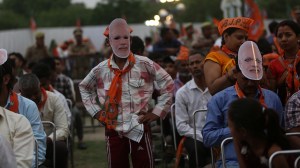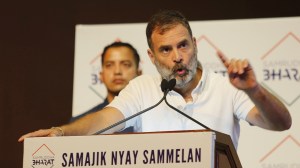- India
- International
Remembering Vikram Sarabhai in his birth centenary year
The architect of India's space programme founded 38 institutions, many of which continue to be a critical part of the country's missions.
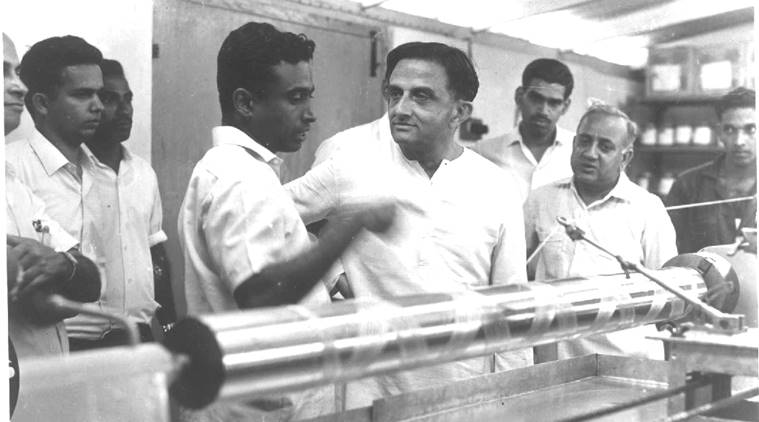 The Man & His World: Vikram Sarabhai with scientists at the Thumba Equatorial Rocket Launching Station, 1969.
The Man & His World: Vikram Sarabhai with scientists at the Thumba Equatorial Rocket Launching Station, 1969.
LAST WEEK, scientists from all corners of India descended on Ahmedabad to remember a man whom the late president, APJ Abdul Kalam, had famously termed “Mahatma Gandhi of Indian Science”.
They were there to launch celebrations on the birth centenary of Vikram Sarabhai, 47 years after he was found dead in a hotel room in Kovalam in Kerala at the age of 52, by when he had founded 38 institutions that are now leaders in space research, physics, management and performing arts.
Former director of the Space Applications Centre Pramod Kale was a 19-year old science graduate from MS University of Baroda, besotted by space technology, when he first met Sarabhai. “In May 1960, I went to Ahmedabad to meet Dr Sarabhai. At the time, his office was at the Calico Mills which is where I met him and ended up talking for two hours,” Kale says.
By June that year, Kale had done exactly as Sarabhai had advised him and taken up a master’s course at Gujarat University. In 1962, when Sarabhai was looking at studying the magnetic equator, Kale went on to be among the first few to go to NASA to learn radar tracking.
The room resounded with many such memories. Former ISRO chairman K Kasturirangan remembered how they ran into some trouble at the Physical Research Laboratory (PRL), founded in 1947 by Sarabhai, in their attempts to fly a balloon at 4 am, when in sailed Sarabhai. “He told us had the flight been successful, you would not have learnt even half of what you learnt because of that initial problem,” said Kasturirangan.
Many of those who had collected in Ahmedabad in Sarabhai’s memory were teenagers when they first met him. Gandhinagar-based entrepreneur K Subramanian was 19 and a student of National Institute of Technology, Tiruchirappalli, working on a summer project at PRL, when a man in a kurta-pyjama walked in and began turning all the wastepaper bins upside down, inspecting their contents and putting them back again. “I asked a colleague who that was and was told it is Dr Vikram Sarabhai. He had come to check how much waste the lab was generating,” laughs Subramanian.

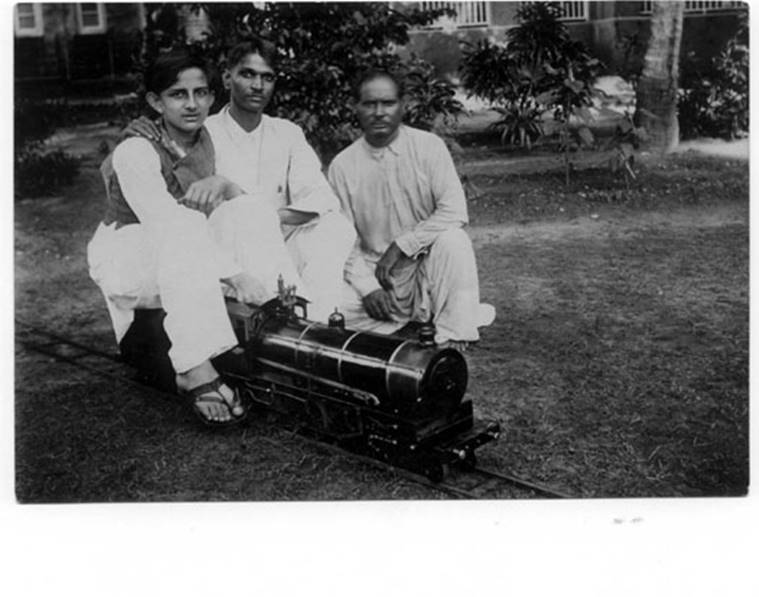 Vikram Sarabhai with the engine he built.
Vikram Sarabhai with the engine he built.
Born to Ambalal and Sarla Devi, Ahmedabad’s leading textile-mill owners, Vikram Sarabhai showed creative promise early. He was 15 when he built a working model of a train engine with the help of two engineers, which is now housed at the Community Science Centre (CSC) in Ahmedabad. The CSC was Vikram’s way of providing other children the privileges he had, of experimental research, says his son Kartikeya, 71, adding how his father wished to work with children at the science centre after he retired.
“He was essentially a researcher, and believed that people, especially children, should be allowed to think freely and come up with solutions on their own,” recalls Kartikeya, who founded the Centre for Environment Education in 1984. His sister and Indian classical dancer Mallika recalls how, as children, they were at the centre of every family decision. This freedom helped “garner convictions early in life and to take a position. You were never too young to be able to be involved in what was going on or what affected you,” says Mallika, 65. Kartikeya is carefully piecing together all the dog-eared notes he is discovering in the recesses of their three grand homes — Shanti Sadan, The Retreat and Chidambaram.
To inspire the young to dream like Sarabhai, Kartikeya is building a permanent exhibition gallery on the Sabarmati Riverfront, expected to open this November, while Mallika is in talks with ISRO and is designing a performance to attract the young to careers in science. Their father would have approved.
After studying from Gujarat University in Ahmedabad, Sarabhai went to study physics and mathematics at Cambridge University, with a reference from Rabindranath Tagore, but was forced to return when World War II broke out. He completed his post-graduation at the Indian Institute of Science in Bengaluru under Dr CV Raman, where he also met Dr Homi Bhabha, and returned later to Cambridge for a PhD in cosmic rays. When Sarabhai and Indian classical dancer Mrinalini Swaminathan married in 1942, the Quit India movement had broken out and his eldest sister Mridula had been arrested. None of the family could attend the wedding except Vikram’s driver, Lala, recalls Kartikeya.
 Vikram Sarabhai with daughter Mallika and son Kartikeya.
Vikram Sarabhai with daughter Mallika and son Kartikeya.
The PRL, ISRO’s predecessor, the Indian National Committee for Space Research as well as the Space Applications Centre in Ahmedabad are the cradle of India’s space programme, and continue to be a critical part of the country’s missions. Sarabhai’s research-and applications-based approach singled him out as a scientist and entrepreneur who lived ahead of his time.
Those who worked closely with Sarabhai say he was quick to recognise people’s capabilities, which made him an exceptional manager. In 1963, NASA was keen on only PhD fellows to impart its technical know-how to. “NASA reasoned that they wanted only people who spoke English and, thus, insisted on PhD as the minimum requirement, but Dr Sarabhai managed to assure them that Indians spoke English without a PhD as well,” says Kale.
Padmanabh Joshi who works with the Nehru Foundation for Development remembers his first meeting meeting with him when he was 17 and working on a socio-economic survey commissioned by Sarabhai. Joshi had asked him the connection between atomic energy and the survey. “Vikrambhai laughed and told me how, in the future, if we were to use satellites to spread education in villages, we would need to know their levels of understanding. The word ‘satellite’ confounded me and he explained: ‘If you stick a mirror on the ceiling and beam a torch on it, what will happen? It will reflect back. Same with satellites’.” Joshi went on to co-author his biography, Vikram Sarabhai — India’s Space Pioneer.
Giving flight to Sarabhai’s dream of probing the atmospheric regions for space research, was the first sounding rocket that was launched from Thumba, in Kerala, in 1967. “He was already talking of launching satellites in 1969. He knew we not only had to look at earth but the near space as well. He would keep saying, we shouldn’t fall behind other nations in the realisation of our space programme. PRL was shaped through three arms — Dr Sarabhai and his team looking at cosmic rays, KR Ramanathan and his team looking at upper atmosphere and Sudhir Pandya who looked at the theoretical physics aspect. I think he would’ve really appreciated how the space programme has shaped up in India,” says Kale.
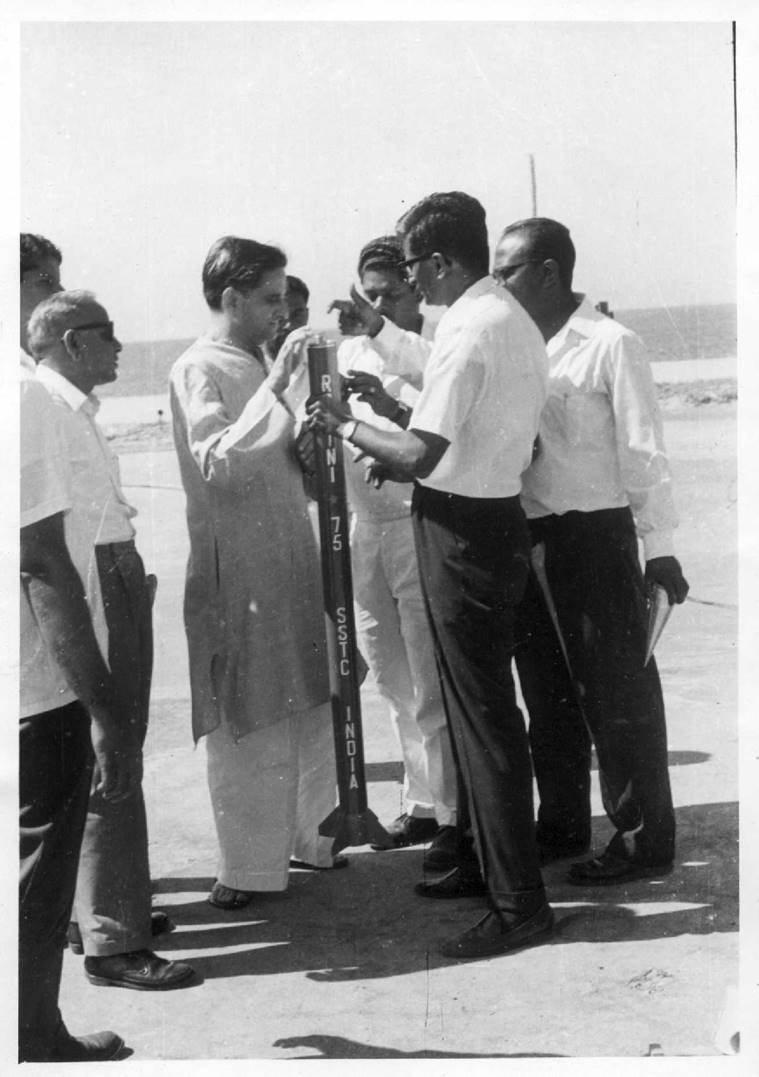 Mahadevan Nair (from left), Dr APJ Abdul Kalam, Sarabhai and HGS Murthy at the Space Science and Technology Centre, Thiruvananthapuram, 1970.
Mahadevan Nair (from left), Dr APJ Abdul Kalam, Sarabhai and HGS Murthy at the Space Science and Technology Centre, Thiruvananthapuram, 1970.
Sarabhai had convinced Parliament and the Planning Commission in 1969 on the merits of “decade profile”, as he envisioned the Indian nuclear programme. The short-term goal-oriented approach, followed especially in universities, might have disappointed him today. In 1966, when Sarabhai took over as Atomic Energy Commission chairman after Homi Bhabha’s death in a plane crash, he started a dialogue with NASA that formed the base for Satellite Instructional Television Experiment. Launched in 1975 from village Pij in Gujarat’s Kheda district, it would beam TV programmes to villages and was the first Indo-US space venture using technology for education. This was how the Krishi Darshan programme for farmers on Doordarshan was conceived.
Sarabhai extended his research emphasis even to business, when he founded Sarabhai Chemicals in Vadodara in 1943, and subsequently the Sarabhai Research Centre and the Operations Research Group.
According to Mallika, had her father been alive, “a lot of things in India would have been very different. Because there have been very few people who have the deep commitment, the wherewithal, the world view and the power to sway policy making”.
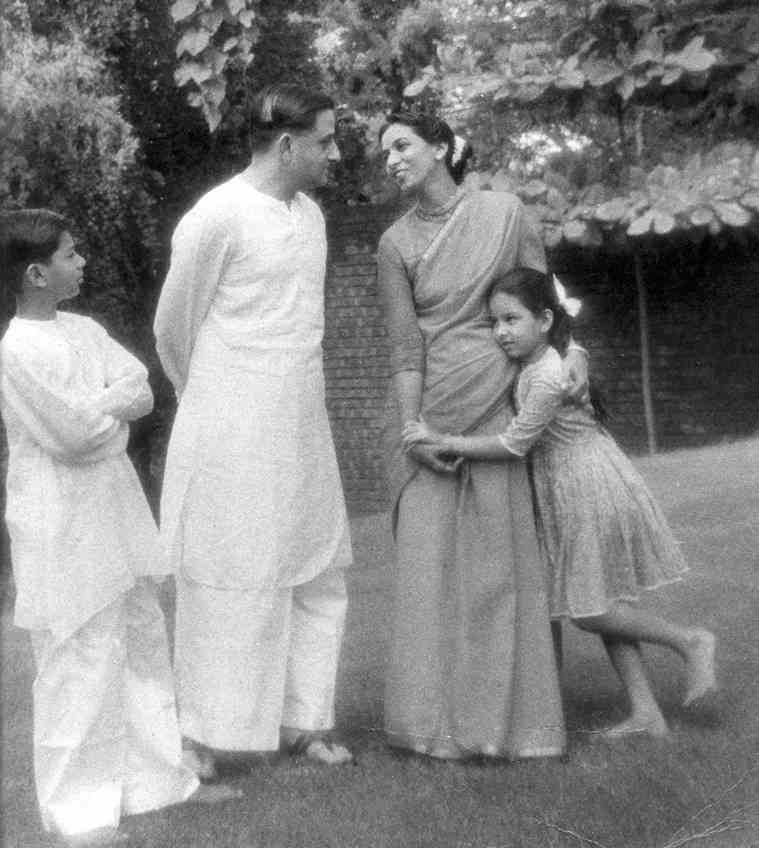 Vikram Sarabhai with wife Mrinalini, Mallika and Kartikeya.
Vikram Sarabhai with wife Mrinalini, Mallika and Kartikeya.
A man of many parts, Sarabhai’s students and colleagues would often wonder how he found the time for everything. Ahmedabad-based architect Kamal Mangaldas remembers how Sarabhai one day asked for a site plan for a project for the Electronic Corporation of India Ltd in Hyderabad which had been awarded to him and well-known architects Balkrishna Doshi and Charles Correa. “After seeing the plan, he came back in 10-15 minutes and changed everything,” says Mangaldas, who designed Sarabhai’s study outside their home on the banks of Sabarmati. “Later I watched it get washed away in the floods after Vikrambhai’s death,” he says.
Last year, Ahmedabad dedicated its first public memorial to Sarabhai — a statue of him seated on a desk overlooking the river, right below the patch where once stood his study.
Apr 25: Latest News
- 01
- 02
- 03
- 04
- 05
















